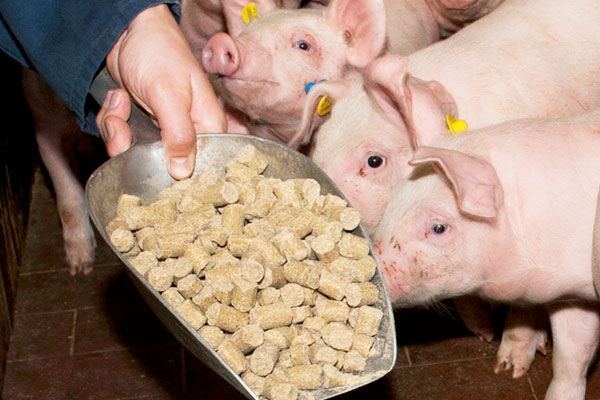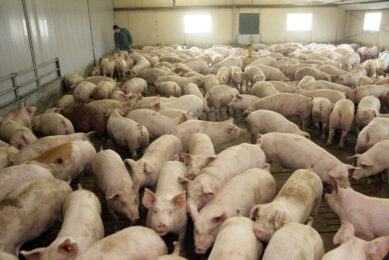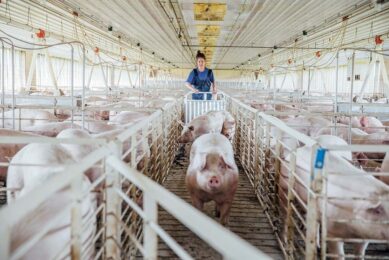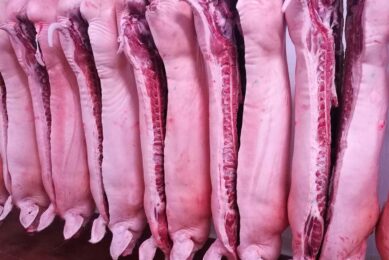Larger pellets to overcome growth check at weaning

Providing extra large pellets for creep feeding appears to positively influence feed intake both prior to as well as after weaning. Research at Wageningen University, the Netherlands, shows that piglets like large pellets.
By Vincent ter Beek
Whether in nature or on a farm, at some point all young pigs will move away from their mothers – and stop consuming sow milk. The rest of the world awaits them, which includes other animals, another environment and also solid feed.
Where in nature, the transition may be gradual, on-farm, however, the transition is abrupt and consequences are ubiquitous. At weaning, piglets may stop eating for as long as two entire days. This in turn can result in a low nutrient intake, impaired intestinal functioning and a poor growth rate to stress and behavioural problems. Needless to say that the pig industry all over the world is wrecking its mind on how to make the weaning transition as smooth as possible.
An easier transition can consist of providing the young piglets with limited amounts of solid feed prior to weaning. This creep feed has always come in small pellets – probably to accommodate the feed to its destined consumers, also being very small. Now exactly that is something that should have rung a bell years ago, but only did recently, explains Henry van den Brand, Wageningen University. “What do we humans give to our toddlers to keep themselves occupied? Certainly not very small pieces of toys! We give them larger toys, like Duplo – this is because the very young kids’ motoric system is simply not ready yet for very detailed, minute elements.” So, his question was – why are young piglets fed minuscule particles of 2 mm?
Nature provided support for this theory. Young piglets from wild boars are found to be running around and playing with e.g. acorns or corn as from ten to 14 days of age. Having an ideal jaw size for 10-15 mm items, the piglets are known to play with acorns, drop them on the floor and pick them up again. And soon, they can handle these as food items too.
Theories
“It certainly wasn’t coincidence to dive into this idea,” Van den Brand explains. “For years and years we have been focusing on ways to reduce the effect of the growth check around weaning. Once we had the idea of feeding large pellets, we noticed there hadn’t been a lot of literature written about it – and thus we took the step of doing research ourselves.”
The initial trials confirmed the team’s suspicions. When equal groups of pigs were fed creep feed of either 2 mm in diameter or 12 mm in diameter, the piglets provided with the larger pellets had a higher feed intake. Another trial, providing pellets of 10 mm diameter, also yielded a higher feed intake than the 2 mm group.
These results were considered remarkable – and even exciting. But where it really matters, is what happens after weaning. Does this different type of creep feed also influence feed intake and pig weight in the long term? The answer appeared to be ‘yes’ – as the next set of tests pointed to a positive effect up to ten days after weaning (387 g/ day with 12 mm pellets vs 354 g/ day with 2 mm pellets).
To have the effect also established in farm conditions, the researchers teamed up with Coppens, a Dutch-based animal nutrition company, headquartered in Helmond. They had a 14 mm diameter creep feed pellet produced and used it in 12 trials on 11 different farms during days 3-18 of lactation. These trials each included at least ten litters every time. Initial focus was on the development on pre-weaning feed intake. Results were postive, as can be seen in Figure 1. On average, there was a 51% higher creep feed intake.
The higher feed intake did not yet lead to higher weaning weights. In six out of these 12 farms, the researchers zoomed in on growth figures during the first 14 days after weaning, this pattern changed. Now the results were positive with an absolute weight gain of 189 g/ day (control group) versus 217 g/ day for the 14 mm pellets after two weeks.
In short, the researchers have something to build on, with larger pellets increasing both pre- and post-weaning feed intake, increasing post-weaning weight gain and thus apparently reducing the post-weaning dip.
Last but not least – researchers and pig producers also noted a behavioural effect, as the piglets fed the larger pellets appeared more active than their fellow trial animals fed normal creep feed. As if the pellets were acorns, the piglets grabbed the feed in their mouths and dragged them through the pens. Initially this was mostly playing behaviour, but after a few days they started eating as well. Not much of the large pellets were wasted, the researchers said. Since the pellets are large they do not fit through slats. And if they happened to be left somewhere close to a sow, they simply disappeared and ended up in her stomach.
XL on the market
Animal nutrition company Coppens got involved with the large pellet concept in late 2012 – and has since introduced it as Baby Big XL on the Dutch market, with sales in surrounding Germany and Belgium too. It took some while to convince both producers as well as own sales staff to accept the new approach, but reactions from pleasantly surprised producers came back soon, explains Evelien Alderliesten, R&D manager, Coppens. Inspiration for the pellets was taken from horse feed production, aiming for a consistency that is between too hard (non-chewable) and too soft (falling apart). There are plans to make the product available to producers all over the world – for more information, www.coppens.nl.
Join 18,000+ subscribers
Subscribe to our newsletter to stay updated about all the need-to-know content in the pigsector, three times a week. Beheer
Beheer










 WP Admin
WP Admin  Bewerk bericht
Bewerk bericht